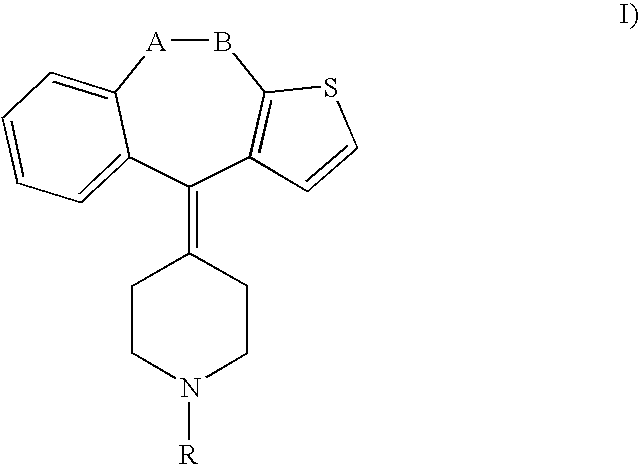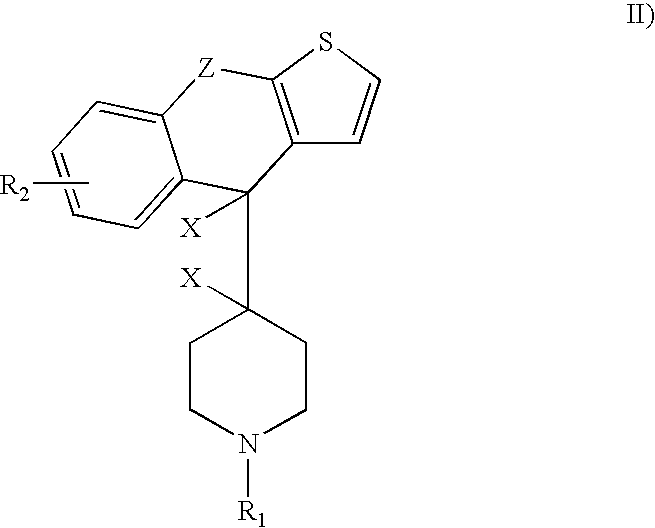Methods
a prophylactic treatment and anti-allergic technology, applied in the field of prophylactic treatment, can solve the problems of 3% severe allergic reaction, leakage of capillaries, swelling of lips, tongue, etc., and achieve the effect of easing side effects
- Summary
- Abstract
- Description
- Claims
- Application Information
AI Technical Summary
Benefits of technology
Problems solved by technology
Method used
Image
Examples
example 1
The Use of Ketotifen in Patients with Peanut Allergy
[0222]To analyze hypersensitivity to an allergen, e.g., peanut, a double-blind, randomized, dose-ranging study is carried out with patients with a history of peanut allergy manifested by urticaria, angioedema, respiratory tract symptoms or hypotension generally using the methods described in Israel et al., Am. J. Respir. Crit. Care Med., (2000) 164:75-80. Eligible patients include those with serum total IgE level of 30-1000 IU / mL and / or a positive skin-prick test to peanut. Patients must have asthma condition under control with a forced expiratory volume in one second that is at least 80 percent of the predicted value. Patients may not have taken systemic corticosteroids, beta-blockers, acetylcholinesterase, aspirin, antihistamines and anti-depressants prior to and throughout the study.
[0223]Before enrollment, threshold level for reactivity to peanut allergen is confirmed by a screening double-blind, placebo-controlled oral food ch...
example 2
The Use of Ketotifen in Patients with Ragweed (Airborne) Allergy
[0228]The use of ketotifen in patients with airborne allergen, e.g., pollen, ragweed, etc., may be carried out similar to Example 1 except airborne allergen extract, e.g., pollen extract or ragweed extract, is used instead of oral peanut allergen.
example 3
The Use of Ketotifen in Patients Undergoing Allergen Desensitization for Peanut Allergy
[0229]To analyze hypersensitivity to peanut, a double-blind, randomized, dose-ranging study is carried out with patients with a history of peanut allergy manifested by urticaria, angioedema, respiratory tract symptoms or hypotension generally using the methods described in Israel et al., Am. J. Respir. Crit. Care Med., (2000) 164:75-80. Eligible patients include those with serum total IgE level of 30-1000 IU / mL and / or a positive skin-prick test to peanut. Patients must have asthma condition under control with a forced expiratory volume in one second that is at least 80 percent of the predicted value. Patients may not take systemic corticosteroids, beta-blockers, acetylcholinesterase, aspirin, antihistamines and anti-depressants during the study.
[0230]Before enrollment, threshold level for reactivity to peanut allergen is confirmed by a screening double-blind, placebo-controlled oral food challenge...
PUM
| Property | Measurement | Unit |
|---|---|---|
| wheal diameter | aaaaa | aaaaa |
| diameter | aaaaa | aaaaa |
| concentration | aaaaa | aaaaa |
Abstract
Description
Claims
Application Information
 Login to View More
Login to View More - R&D
- Intellectual Property
- Life Sciences
- Materials
- Tech Scout
- Unparalleled Data Quality
- Higher Quality Content
- 60% Fewer Hallucinations
Browse by: Latest US Patents, China's latest patents, Technical Efficacy Thesaurus, Application Domain, Technology Topic, Popular Technical Reports.
© 2025 PatSnap. All rights reserved.Legal|Privacy policy|Modern Slavery Act Transparency Statement|Sitemap|About US| Contact US: help@patsnap.com



